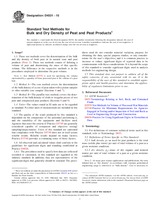Potrebujeme váš súhlas na využitie jednotlivých dát, aby sa vám okrem iného mohli ukazovať informácie týkajúce sa vašich záujmov. Súhlas udelíte kliknutím na tlačidlo „OK“.
ASTM D4531-15
Standard Test Methods for Bulk and Dry Density of Peat and Peat Products
Automaticky preložený názov:
Štandardné metódy skúšok pre produkčné a hustoty suchej rašeliny a rašeliny produkty
NORMA vydaná dňa 15.7.2015
Informácie o norme:
Označenie normy: ASTM D4531-15
Poznámka: NEPLATNÁ
Dátum vydania normy: 15.7.2015
Kód tovaru: NS-612503
Počet strán: 3
Približná hmotnosť: 9 g (0.02 libier)
Krajina: Americká technická norma
Kategória: Technické normy ASTM
Kategórie - podobné normy:
Anotácia textu normy ASTM D4531-15 :
Keywords:
bulk density, core sampling, dry density, paraffin-wax displacement method, peat, peat products,, ICS Number Code 65.080 (Fertilizers)
Doplňujúce informácie
| Significance and Use | ||||||||
|
4.1 These test methods provide uniform procedures for determining the bulk density of in situ peat and processed peat products. The bulk density is of use in the calculation of in situ stresses for engineering analysis and in quantifying the amount of material present when considering peat as a resource. In the latter case, it is necessary to consider the moisture condition for which the bulk density was determined; a more useful parameter to consider may well be the dry density, ρNote 3: The quality of the result produced by this standard is dependent on the competence of the personnel performing it, and the suitability of the equipment and facilities used. Agencies that meet the criteria of Practice D3740 are generally considered capable of competent and objective testing/sampling/inspection/etc. Users of this standard are cautioned that compliance with Practice D3740 does not in itself assure reliable results. Reliable results depend on many factors; Practice D3740 provides a evaluating some of those factors. |
||||||||
| 1. Scope | ||||||||
|
1.1 These test methods cover the determination of the bulk and dry density of both peat in its natural state and peat products (Note 1). These test methods consist of defining a volume of peat and determining the mass of that specific volume. The difference in the respective methods is in the procedures employed to determine the peat volume. Note 1: Test Method D2978 is used for specifying the volume
represented by a quantity of loose processed peat or the volume of
a peat bale.
1.2 Method A—The core method covers the determination of the bulk density of a core of peat taken with a piston sampler or other suitable core sampler (Sections 6 and 7). 1.3 Method B—The paraffin wax method, covers the determination of the bulk density of clods or irregular pieces of wet peat and compressed peat products (Sections 8 and 9). 1.4 Units—The values stated in SI units are to be regarded as standard. No other units of measurement are included in this standard. 1.5 The quality of the result produced by this standard is dependent on the competence of the personnel performing it, and the suitability of the equipment and facilities used. Agencies that meet the criteria of Practice D3740 are generally considered capable of competent and objective testing/sampling/inspection/etc. Users of this standard are cautioned that compliance with Practice D3740 does not in itself assure reliable results. Reliable results depend on many factors; Practice D3740 provides a evaluating some of those factors. 1.6 All observed and calculated values shall conform to the guidelines for significant digits and rounding established in Practice D6026. 1.6.1 The procedures used to specify how data are collected/recorded or calculated, in this standard are regarded as the industry standard. In addition, they are representative of the significant digits that generally should be retained. The procedures used do not consider material variation, purpose for obtaining the data, special purpose studies, or any considerations for the user's objectives; and it is common practice to increase or reduce significant digits of reported data to be commensurate with these considerations. It is beyond the scope of this standard to consider significant digits used in analysis methods for engineering design. 1.7 This standard does not purport to address all of the safety concerns, if any, associated with its use. It is the responsibility of the user of this standard to establish appropriate safety and health practices and determine the applicability of regulatory limitations prior to use. |
||||||||
| 2. Referenced Documents | ||||||||
|




 Cookies
Cookies
